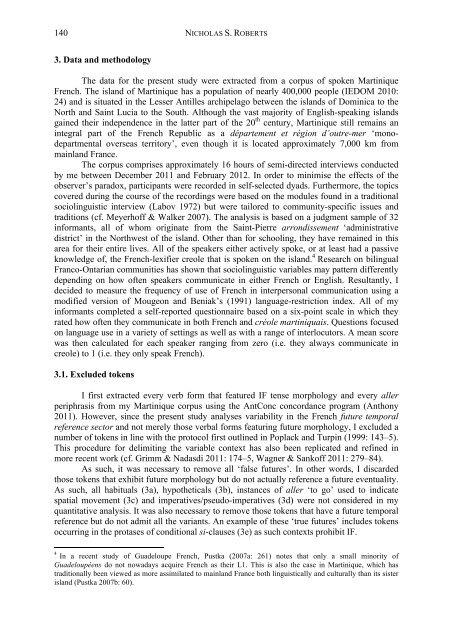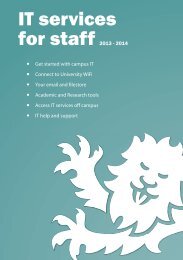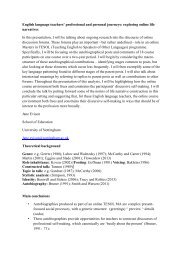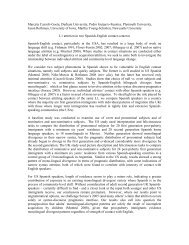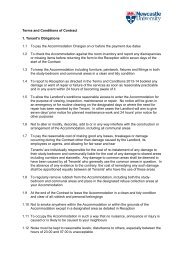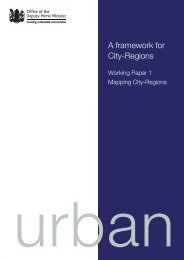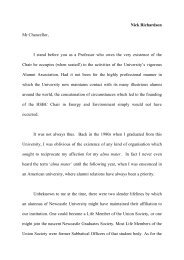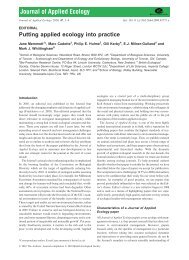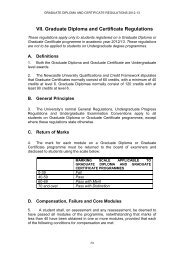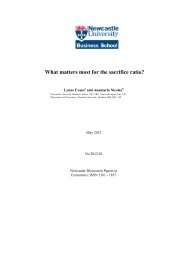the influence of linguistic factors on the expression of futurity
the influence of linguistic factors on the expression of futurity
the influence of linguistic factors on the expression of futurity
Create successful ePaper yourself
Turn your PDF publications into a flip-book with our unique Google optimized e-Paper software.
140<br />
NICHOLAS S. ROBERTS<br />
3. Data and methodology<br />
The data for <str<strong>on</strong>g>the</str<strong>on</strong>g> present study were extracted from a corpus <str<strong>on</strong>g>of</str<strong>on</strong>g> spoken Martinique<br />
French. The island <str<strong>on</strong>g>of</str<strong>on</strong>g> Martinique has a populati<strong>on</strong> <str<strong>on</strong>g>of</str<strong>on</strong>g> nearly 400,000 people (IEDOM 2010:<br />
24) and is situated in <str<strong>on</strong>g>the</str<strong>on</strong>g> Lesser Antilles archipelago between <str<strong>on</strong>g>the</str<strong>on</strong>g> islands <str<strong>on</strong>g>of</str<strong>on</strong>g> Dominica to <str<strong>on</strong>g>the</str<strong>on</strong>g><br />
North and Saint Lucia to <str<strong>on</strong>g>the</str<strong>on</strong>g> South. Although <str<strong>on</strong>g>the</str<strong>on</strong>g> vast majority <str<strong>on</strong>g>of</str<strong>on</strong>g> English-speaking islands<br />
gained <str<strong>on</strong>g>the</str<strong>on</strong>g>ir independence in <str<strong>on</strong>g>the</str<strong>on</strong>g> latter part <str<strong>on</strong>g>of</str<strong>on</strong>g> <str<strong>on</strong>g>the</str<strong>on</strong>g> 20 th century, Martinique still remains an<br />
integral part <str<strong>on</strong>g>of</str<strong>on</strong>g> <str<strong>on</strong>g>the</str<strong>on</strong>g> French Republic as a département et régi<strong>on</strong> d’outre-mer ‘m<strong>on</strong>odepartmental<br />
overseas territory’, even though it is located approximately 7,000 km from<br />
mainland France.<br />
The corpus comprises approximately 16 hours <str<strong>on</strong>g>of</str<strong>on</strong>g> semi-directed interviews c<strong>on</strong>ducted<br />
by me between December 2011 and February 2012. In order to minimise <str<strong>on</strong>g>the</str<strong>on</strong>g> effects <str<strong>on</strong>g>of</str<strong>on</strong>g> <str<strong>on</strong>g>the</str<strong>on</strong>g><br />
observer’s paradox, participants were recorded in self-selected dyads. Fur<str<strong>on</strong>g>the</str<strong>on</strong>g>rmore, <str<strong>on</strong>g>the</str<strong>on</strong>g> topics<br />
covered during <str<strong>on</strong>g>the</str<strong>on</strong>g> course <str<strong>on</strong>g>of</str<strong>on</strong>g> <str<strong>on</strong>g>the</str<strong>on</strong>g> recordings were based <strong>on</strong> <str<strong>on</strong>g>the</str<strong>on</strong>g> modules found in a traditi<strong>on</strong>al<br />
socio<str<strong>on</strong>g>linguistic</str<strong>on</strong>g> interview (Labov 1972) but were tailored to community-specific issues and<br />
traditi<strong>on</strong>s (cf. Meyerh<str<strong>on</strong>g>of</str<strong>on</strong>g>f & Walker 2007). The analysis is based <strong>on</strong> a judgment sample <str<strong>on</strong>g>of</str<strong>on</strong>g> 32<br />
informants, all <str<strong>on</strong>g>of</str<strong>on</strong>g> whom originate from <str<strong>on</strong>g>the</str<strong>on</strong>g> Saint-Pierre arr<strong>on</strong>dissement ‘administrative<br />
district’ in <str<strong>on</strong>g>the</str<strong>on</strong>g> Northwest <str<strong>on</strong>g>of</str<strong>on</strong>g> <str<strong>on</strong>g>the</str<strong>on</strong>g> island. O<str<strong>on</strong>g>the</str<strong>on</strong>g>r than for schooling, <str<strong>on</strong>g>the</str<strong>on</strong>g>y have remained in this<br />
area for <str<strong>on</strong>g>the</str<strong>on</strong>g>ir entire lives. All <str<strong>on</strong>g>of</str<strong>on</strong>g> <str<strong>on</strong>g>the</str<strong>on</strong>g> speakers ei<str<strong>on</strong>g>the</str<strong>on</strong>g>r actively spoke, or at least had a passive<br />
knowledge <str<strong>on</strong>g>of</str<strong>on</strong>g>, <str<strong>on</strong>g>the</str<strong>on</strong>g> French-lexifier creole that is spoken <strong>on</strong> <str<strong>on</strong>g>the</str<strong>on</strong>g> island. 4 Research <strong>on</strong> bilingual<br />
Franco-Ontarian communities has shown that socio<str<strong>on</strong>g>linguistic</str<strong>on</strong>g> variables may pattern differently<br />
depending <strong>on</strong> how <str<strong>on</strong>g>of</str<strong>on</strong>g>ten speakers communicate in ei<str<strong>on</strong>g>the</str<strong>on</strong>g>r French or English. Resultantly, I<br />
decided to measure <str<strong>on</strong>g>the</str<strong>on</strong>g> frequency <str<strong>on</strong>g>of</str<strong>on</strong>g> use <str<strong>on</strong>g>of</str<strong>on</strong>g> French in interpers<strong>on</strong>al communicati<strong>on</strong> using a<br />
modified versi<strong>on</strong> <str<strong>on</strong>g>of</str<strong>on</strong>g> Mouge<strong>on</strong> and Beniak’s (1991) language-restricti<strong>on</strong> index. All <str<strong>on</strong>g>of</str<strong>on</strong>g> my<br />
informants completed a self-reported questi<strong>on</strong>naire based <strong>on</strong> a six-point scale in which <str<strong>on</strong>g>the</str<strong>on</strong>g>y<br />
rated how <str<strong>on</strong>g>of</str<strong>on</strong>g>ten <str<strong>on</strong>g>the</str<strong>on</strong>g>y communicate in both French and créole martiniquais. Questi<strong>on</strong>s focused<br />
<strong>on</strong> language use in a variety <str<strong>on</strong>g>of</str<strong>on</strong>g> settings as well as with a range <str<strong>on</strong>g>of</str<strong>on</strong>g> interlocutors. A mean score<br />
was <str<strong>on</strong>g>the</str<strong>on</strong>g>n calculated for each speaker ranging from zero (i.e. <str<strong>on</strong>g>the</str<strong>on</strong>g>y always communicate in<br />
creole) to 1 (i.e. <str<strong>on</strong>g>the</str<strong>on</strong>g>y <strong>on</strong>ly speak French).<br />
3.1. Excluded tokens<br />
I first extracted every verb form that featured IF tense morphology and every aller<br />
periphrasis from my Martinique corpus using <str<strong>on</strong>g>the</str<strong>on</strong>g> AntC<strong>on</strong>c c<strong>on</strong>cordance program (Anth<strong>on</strong>y<br />
2011). However, since <str<strong>on</strong>g>the</str<strong>on</strong>g> present study analyses variability in <str<strong>on</strong>g>the</str<strong>on</strong>g> French future temporal<br />
reference sector and not merely those verbal forms featuring future morphology, I excluded a<br />
number <str<strong>on</strong>g>of</str<strong>on</strong>g> tokens in line with <str<strong>on</strong>g>the</str<strong>on</strong>g> protocol first outlined in Poplack and Turpin (1999: 143–5).<br />
This procedure for delimiting <str<strong>on</strong>g>the</str<strong>on</strong>g> variable c<strong>on</strong>text has also been replicated and refined in<br />
more recent work (cf. Grimm & Nadasdi 2011: 174–5, Wagner & Sank<str<strong>on</strong>g>of</str<strong>on</strong>g>f 2011: 279–84).<br />
As such, it was necessary to remove all ‘false futures’. In o<str<strong>on</strong>g>the</str<strong>on</strong>g>r words, I discarded<br />
those tokens that exhibit future morphology but do not actually reference a future eventuality.<br />
As such, all habituals (3a), hypo<str<strong>on</strong>g>the</str<strong>on</strong>g>ticals (3b), instances <str<strong>on</strong>g>of</str<strong>on</strong>g> aller ‘to go’ used to indicate<br />
spatial movement (3c) and imperatives/pseudo-imperatives (3d) were not c<strong>on</strong>sidered in my<br />
quantitative analysis. It was also necessary to remove those tokens that have a future temporal<br />
reference but do not admit all <str<strong>on</strong>g>the</str<strong>on</strong>g> variants. An example <str<strong>on</strong>g>of</str<strong>on</strong>g> <str<strong>on</strong>g>the</str<strong>on</strong>g>se ‘true futures’ includes tokens<br />
occurring in <str<strong>on</strong>g>the</str<strong>on</strong>g> protases <str<strong>on</strong>g>of</str<strong>on</strong>g> c<strong>on</strong>diti<strong>on</strong>al si-clauses (3e) as such c<strong>on</strong>texts prohibit IF.<br />
4 In a recent study <str<strong>on</strong>g>of</str<strong>on</strong>g> Guadeloupe French, Pustka (2007a: 261) notes that <strong>on</strong>ly a small minority <str<strong>on</strong>g>of</str<strong>on</strong>g><br />
Guadeloupéens do not nowadays acquire French as <str<strong>on</strong>g>the</str<strong>on</strong>g>ir L1. This is also <str<strong>on</strong>g>the</str<strong>on</strong>g> case in Martinique, which has<br />
traditi<strong>on</strong>ally been viewed as more assimilated to mainland France both <str<strong>on</strong>g>linguistic</str<strong>on</strong>g>ally and culturally than its sister<br />
island (Pustka 2007b: 60).


